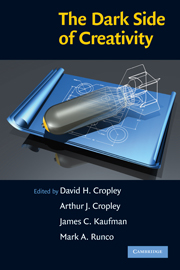Book contents
- Frontmatter
- Contents
- List of Contributors
- 1 The Dark Side of Creativity: What Is It?
- 2 Creativity Has No Dark Side
- 3 Positive Creativity and Negative Creativity (and Unintended Consequences)
- 4 Subjugating the Creative Mind: The Soviet Biological Weapons Program and the Role of the State
- 5 Imagining the Bomb: Robert Oppenheimer, Nuclear Weapons, and the Assimilation of Technological Innovation
- 6 The Innovation Dilemma: Some Risks of Creativity in Strategic Agency
- 7 Early Creativity as a Constraint on Future Achievement
- 8 Boundless Creativity
- 9 Reviewing the Art of Crime: What, If Anything, Do Criminals and Artists/Designers Have in Common?
- 10 Creativity in Confinement
- 11 Creativity and Crime: How Criminals Use Creativity to Succeed
- 12 So You Want to Become a Creative Genius? You Must Be Crazy!
- 13 Both Sides of the Coin? Personality, Deviance, and Creative Behavior
- 14 Neurosis: The Dark Side of Emotional Creativity
- 15 Dangling from a Tassel on the Fabric of Socially Constructed Reality: Reflections on the Creative Writing Process
- 16 Creativity in the Classroom: The Dark Side
- 17 The Dark Side of Creativity and How to Combat It
- 18 A Systems Engineering Approach to Counterterrorism
- 19 Malevolent Innovation: Opposing the Dark Side of Creativity
- 20 Summary – The Dark Side of Creativity: A Differentiated Model
- Index
- References
19 - Malevolent Innovation: Opposing the Dark Side of Creativity
Published online by Cambridge University Press: 05 June 2012
- Frontmatter
- Contents
- List of Contributors
- 1 The Dark Side of Creativity: What Is It?
- 2 Creativity Has No Dark Side
- 3 Positive Creativity and Negative Creativity (and Unintended Consequences)
- 4 Subjugating the Creative Mind: The Soviet Biological Weapons Program and the Role of the State
- 5 Imagining the Bomb: Robert Oppenheimer, Nuclear Weapons, and the Assimilation of Technological Innovation
- 6 The Innovation Dilemma: Some Risks of Creativity in Strategic Agency
- 7 Early Creativity as a Constraint on Future Achievement
- 8 Boundless Creativity
- 9 Reviewing the Art of Crime: What, If Anything, Do Criminals and Artists/Designers Have in Common?
- 10 Creativity in Confinement
- 11 Creativity and Crime: How Criminals Use Creativity to Succeed
- 12 So You Want to Become a Creative Genius? You Must Be Crazy!
- 13 Both Sides of the Coin? Personality, Deviance, and Creative Behavior
- 14 Neurosis: The Dark Side of Emotional Creativity
- 15 Dangling from a Tassel on the Fabric of Socially Constructed Reality: Reflections on the Creative Writing Process
- 16 Creativity in the Classroom: The Dark Side
- 17 The Dark Side of Creativity and How to Combat It
- 18 A Systems Engineering Approach to Counterterrorism
- 19 Malevolent Innovation: Opposing the Dark Side of Creativity
- 20 Summary – The Dark Side of Creativity: A Differentiated Model
- Index
- References
Summary
Cropley (2005) and Cropley, Kaufman, and Cropley (2008) explored the notion that creativity might be employed with the deliberate intention of causing harm or damage to others (e.g., McLaren, 1993; James, Clark, & Cropanzano, 1999) by focusing on acts of terrorism. One of the starkest examples of such malevolent creativity was seen in the terrorist attacks of September 11, 2001 (9/11). Judged against the criteria of a functionally creative product developed by Cropley and Cropley (2005) – namely, novelty, relevance and effectiveness, elegance and generalizability – Cropley et al. (2008) argued that terrorists, such as those involved in the 9/11 attacks, exploit creativity to help them achieve their goals. Whether used consciously or unconsciously, creativity is as much a weapon for terrorists as it is for business executives.
Cropley et al. (2008) also, however, explored the notion of “decay” in relation to creativity. In essence, every creative product, process, or service, once implemented, sows the seeds of its own destruction. In the case of the 9/11 terrorists, the very novelty that was so spectacularly successful in the Twin Towers and Pentagon attacks had, by the time of the United Airlines (UA93) hijacking, decayed to the point that UA93's passengers responded quite differently, possibly quite creatively, and with some success. The effectiveness of the terrorist attack on UA93 was significantly diminished in comparison with the other attacks on 9/11 (if we assume that, as is generally thought to be the case, the terrorists intended to crash the plane into either the White House or the U.S. Capitol).
- Type
- Chapter
- Information
- The Dark Side of Creativity , pp. 339 - 359Publisher: Cambridge University PressPrint publication year: 2010
References
- 11
- Cited by



